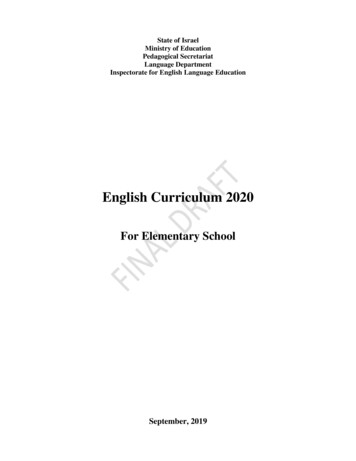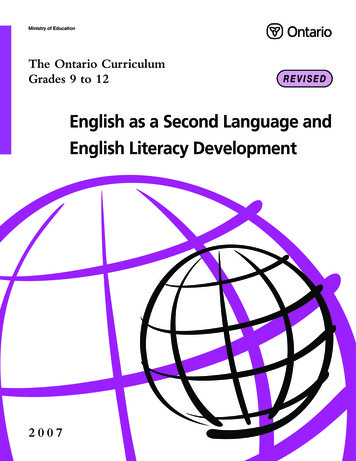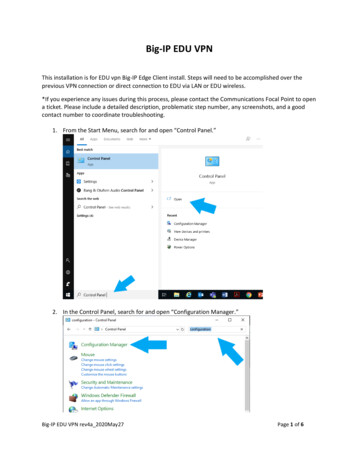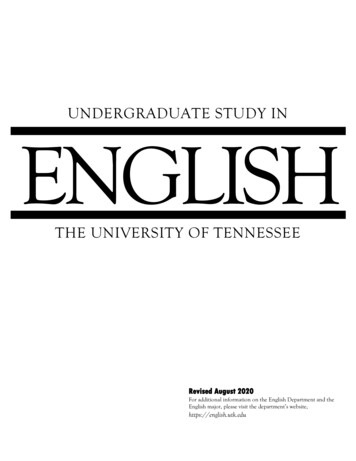
Transcription
State of IsraelMinistry of EducationPedagogical SecretariatLanguage DepartmentInspectorate for English Language EducationEnglish Curriculum 2020For Elementary SchoolSeptember, 2019
English Curriculum 2020For Elementary SchoolSeptember 2019Curriculum Sub-committeeTziona Levi, Chief Inspector for English Language Education, Ministry of EducationElisheva Barkon, Chairperson, Advisory Committee for English Language Education, OranimAcademic College of EducationLisa Amdur, Chairperson, Curriculum Sub-committee, Tel Aviv UniversityElana Spector-Cohen, Tel Aviv UniversityDebbie Lahav, Ruppin Academic CollegeKaren Abel, Beit Berl Academic CollegeMdalale Azam, Regional Counselor, Ministry of EducationAcademic ConsultantsProf. Batia Laufer, Haifa UniversityProf. Elite Olshtain, Hebrew UniversityProf. Penny Ur, Oranim Academic College of Education, Haifa UniversityDiane Schmitt, Nottingham Trent UniversityProf. Norbert Schmitt, University of NottinghamVocabulary Field ConsultantsChemda Benisty, Tichon Kiryat Yam, Haifa, Ministry of EducationVera Kacevich, Oranim School, Yokneam, Ministry of EducationPre Basic User (Pre-A1) ConsultantsJanina Kahn-Horwitz, Oranim College of EducationStephanie Fuchs, Gordon Academic College of EducationAharona Gvaryahu, National Counselor, Ministry of EducationFern Levitt, David Yellin Academic College of EducationSusie Russak, Beit Berl Academic CollegeJackie Teplitz, Gordon Academic College of EducationRita Zeltsman-Kulick, Kibbutzim College of Education, Tel Aviv University1
English Curriculum 2020For Elementary SchoolSeptember 2019Table of ContentsIntroduction4Alignment with the Common European Framework of Reference forLanguages (CEFR)5Curriculum Components7Principles to Guide Teaching Practice9Levels of Progression15Sources for Can-do Statements and Format of Presentation16Vocabulary17Grammar20Pre Basic User (Pre-A1)Activities23Communicative Competences26Basic User I (A1)Activities27Communicative Competences35Grammar36Global Can-do StatementsPre Basic User46Basic User I47References492
English Curriculum 2020For Elementary SchoolSeptember 2019List of TablesTable 1Principles of Language Learning and Language Teaching9Table 2Principles of Beginning Language Learning and LanguageTeaching11Table 3Comparison of Levels15Table 4Vocabulary Bands for Each Level18Table 5Vocabulary Targets for Each Level19Table 6Grammatical Structures for Grades 4, 5 and 636List of FiguresFigure 1Presentation format of activities and can-do statements16Figure 2Presentation format of grammatical structures and can-dostatements223
English Curriculum 2020For Elementary SchoolSeptember 2019IntroductionA dynamic, fast changing world characterized by globalization, technologization, mobility andmigration presents multiple challenges for teaching and learning English. Furthermore, insightsfrom contemporary research in second language acquisition (SLA), learning additional languages,educational technology among other disciplines, invites practitioners to consider how to apply upto-date thinking in classroom practice. The English Curriculum 2020 is the outcome of a revisionand revamping of the Revised English Curriculum 2018. In many respects it is an evolution fromthe previous curriculum, now aligned with international standards with the goal of raising the levelof English language education in the country throughout the school years. In turn, achieving thisgoal will ensure a smooth transition from high school graduation to higher education.David Crystal, in the Cambridge Encyclopedia of the English Language (2003), suggests sixreasons for studying English: it is fascinating, important, fun, beautiful, useful and because it’sthere. Today, without question, English is important and useful as an international language,having taken on the global role of lingua franca in a plethora of work-related, social and culturalcontexts (Ministry of Education, 2017) and is essential in the context of 21st century globalcompetences. For example, it is the language of business and government, is used in internationaltrade and tourism, in academia and research, in electronic media as well as in maritimecommunication and international traffic control (Kitao, 1996). Thus, a central aim of teachingEnglish as an international language should be to equip students with the linguistic tools toeffectively function in a global context (Alsagoff, 2012).Learners are now required to develop a variety of language competences and to use English bothorally and in writing in performing a wide range of tasks. With teacher facilitation they must mastertechnological and intercultural skills and strategies in English through means of multimodalformats. The English Curriculum 2020 is designed to address these needs by aligning with theCommon European Framework of Reference for Languages (CEFR) (Council of Europe, 2011,2018) now commonly used across the globe and which defines the competences necessary forlanguage learners to function and communicate effectively in English.4
English Curriculum 2020For Elementary SchoolSeptember 2019Alignment with the Common European Framework of Reference forLanguages (CEFR)In 2001, the Council of Europe introduced the CEFR, designed to provide a set of clear andcommon standards and concepts for the teaching and assessment of foreign languages in Europe,including English. Since its introduction, it has been adopted in over 120 countries and translatedinto more than 40 languages including Hebrew (NITE, 2017) and Arabic. Furthermore, it is widelyused in an ever-growing number of educational contexts, and has become ‘a common language’with which learners and teachers around the world are already familiar.The CEFR, based on current language education research, emphasizes the multi-dimensionalnature of language learning and promotes the adoption of cutting-edge teaching methods, materialsand tools. As such it serves as a basis for the reconceptualization of English language education inIsrael in line with internationally accepted standards. The reconceptualization of English teachingin higher education and the localization of the CEFR to suit the specific needs of Israeli learnersrecently culminated in the CEFR-Aligned Framework for English in Higher Education in Israel.1Similarly, the English Curriculum 2020 is a product of the reconceptualization of English languageeducation in schools. It is designed to create a continuum of progression from schools to highereducation as well as a bridge between Israeli and global contexts of English worldwide.The adoption and localization of the CEFR to the Israeli context ensures that the EnglishCurriculum 2020: addresses the unique context of Israel taking its ethnically and linguistically heterogeneouspopulation into consideration; provides a high level of specificity and resolution of what is required at each level of study; allows learners to develop meta-awareness of language (as language learning goals aretransparent), to pursue self- and peer-assessment and even more importantly, set their ownlearning goals and take responsibility for their learning; promotes equity and fairness across diverse learner populations; ensures equal opportunities and enhances life chances for learners from different cultures,regions, and sectors; promotes instruction that can open doors to higher education, workplaces and socialopportunities; promotes international recognition by organizations and institutions and enhancesintercultural understanding; supports virtual and physical learner exchanges, participation in national and internationalprojects, and critical and creative thinking through exchanges of ideas with people fromdiverse backgrounds; allows for the use of materials and tests aligned with the CEFR; facilitates the development of high resolution materials and valid, reliable and fair testsaligned with the CEFR; serves as a blueprint for teachers as they create and prepare materials, set learning goals,review exemplars, and assess student work;1CEFR-Aligned Framework for English in Higher Education in Israel (2017). Tempus ECOSTAR: Project . Downloadable from s/2016/04/FRAMEWORK-ATAR-with-preface.pdf5
English Curriculum 2020For Elementary SchoolSeptember 2019 fosters teacher cooperation in Professional Learning Communities (PLCs) as discussionsand sharing revolve around a ‘common language’ and mutual understandings.The English Curriculum 2020, in line with the CEFR, adopts an action-oriented approach to thedescription of communicative proficiency: it perceives the learners as language users with real-lifeneeds. Can-do statements define what English language learners can actually do with language invarying situations, for different purposes, and formulated in positive terms at each level along thejourney toward English language proficiency. Teaching is based on real world communicativecontexts and organized around real-life tasks and teachers share the objectives with the learners.Teachers do not lose their pedagogic freedom; quite the opposite, they make the most of theirprofessional competences while contextualizing teaching abilities.6
English Curriculum 2020For Elementary SchoolSeptember 2019Curriculum ComponentsThe description of what learners can do has two interdependent dimensions: language activitiesand communicative competences. The first comprises reception, production, interaction andmediation; and the second dimension refers to the linguistic, sociolinguistic and pragmatic aspectsof language. The two dimensions are described below.Activities: Reception, Production, Interaction, MediationReceptionIn reception, the user/learner receives and processes language input from an oral or written text,and builds up a representation of the meaning expressed. Reception includes oral reception(listening comprehension) and written reception (reading comprehension).ProductionIn production, the user/learner produces language, orally and in writing. It may involve informalconversations or longer, more formal discourse contexts.InteractionInteraction involves at least two individuals participating in an oral, written and/or onlineexchange. In interaction, production and reception alternate and sometimes overlap.Mediation2In mediation, the user/learner serves as an intermediary for another person who may not haveaccess due to linguistic, cultural, semantic or technical barriers. It may also involve mediating atext for oneself (for example in taking notes) or in expressing reactions to texts, particularlycreative texts. Mediation involves reception and production plus, frequently, interaction.Communicative strategies relevant to each activity (reception, production, interaction, mediation)are also included in the lists of can-do statements. Communicative strategies involve theapplication of metacognitive principles of pre-planning, execution, monitoring and repair inrelation to each of the different activities. They reflect the adoption of a line of action to maximizeeffectiveness and understanding.Communicative CompetencesCommunicative competences include linguistic, sociolinguistic and pragmatic aspects of languagethat enable a person to act using specifically linguistic means.Linguistic competence relates to language usage (as in ‘correct usage’) and includes generallinguistic range, vocabulary size and depth, grammatical accuracy as well as phonological andorthographic control.Sociolinguistic competence defines the knowledge and skills required to deal with the socialdimension of language use, i.e. sociolinguistic appropriateness.2Though mediation was always included in the CEFR, it has recently been further developed. For details see:North, B. & Piccardo, E. (2016). Developing illustrative descriptors of aspects of mediation for the CEFR. Councilof Europe.7
English Curriculum 2020For Elementary SchoolSeptember 2019Pragmatics describes actual language use in the (co-) construction of discourse and relates to howmessages are organized, structured, arranged and used to perform communicative functions.Can-do StatementsA differentiation is made between global can-do statements and operative can-do statements. Aglobal can-do statement is a very general description of what a learner can do with language.Operative can-do statements are more specific in terms of the description of what the learner cando. The majority of global can-do statements are accompanied by a number of operative can-dostatements.DomainsDomains refer to a particular sector or sphere of life. The CEFR defines four domains as follows:Educational domain covers the learning context, mainly formal and institutional frameworks.Occupational domain refers to work-related contexts.Public domain relates to social contexts, including public services, administrative bodies andleisure activities of a public nature.Personal domain concerns an individual’s immediate context, including family relations, homelife, individual interests and leisure activities.Domains, while not specified in the English Curriculum 2020, should be considered whendesigning materials and planning instruction. The personal domain is most relevant for learners inelementary school as, by definition, this domain refers to the immediate needs and surroundingsof the learner. In junior high school learners widen their social circle and thus extend their contactwith the public domain. Educational and occupational domains become most relevant for highschool learners as they expand their academic, professional and vocational engagement withlanguage.VocabularyVocabulary in the English Curriculum 2020 consists of words and chunks divided into bands forelementary, junior high and high school. The bands comprise core foundational vocabularynecessary for spoken and written discourse.GrammarGrammar in the English Curriculum 2020 comprises a lists of structures relevant for each gradelevel with detailed can-do statements. These, provide context to highlight the importance of formin conveying intended meaning.8
English Curriculum 2020For Elementary SchoolSeptember 2019Principles to Guide Teaching PracticeThe adoption and localization of the CEFR in the English Curriculum 2020 can be viewed as anevolutionary process with certain aspects of the previous curriculum preserved or adapted, inparticular the setting out of principles that guide teaching. The principles relate to: a. languagelearning and teaching, b. beginning language learning and teaching, c. selection of materials, d.design of tasks, e. classroom assessment and f. integration of Information and CommunicationsTechnology (ICT).A. Principles underlying language learning and language teachingMeaningful language learning is active, constructive, authentic and cooperative. Learners aremotivated when they can engage in activities that are relevant to their lives. When tasks makesense to and interest learners on a personal level, they are able to relate to them in depth, bothcognitively and affectively. This is particularly appropriate within the action-oriented approachthat characterizes the CEFR.The following principles underlie meaningful language learning and teaching:Table 1Principles of Language Learning and Language TeachingLanguage LearningLanguage TeachingLanguage learning is facilitated whenlearners:Teachers promote learning when they: have maximum exposure to the targetlanguage through encounter with a varietyof spoken and written texts, allowing forincidental acquisition of English. provide learners with opportunities toacquire vocabulary and other languagefeatures incidentally by speaking Englishin the classroom, and by providing alanguage-rich environment with a varietyof verbal and visual stimuli. can use linguistic resources (L1 and otherlanguages) when it helps them understand. recognize the importance of relating tolearners’ linguistic resources (L1,additional languages, English). are motivated and willing to invest timeand effort. choose interesting, relevant andappropriate topics, materials and activities. develop self-efficacy and confidence inusing the language. provide success-oriented tasks andconstructive feedback. are willing to take risks. create a non-threatening and supportivelearning environment that encourages risktaking. build on their world knowledge andlinguistic resources. choose content and language that willbuild on learners’ prior knowledge.9
English Curriculum 2020For Elementary SchoolSeptember 2019Language LearningLanguage TeachingLanguage learning is facilitated whenlearners:Teachers promote learning when they: are aware of their own progress and have asense of accomplishment. provide transparent and attainable goals. are challenged within the range of theirzone of proximal development. provide differentiated instruction. understand language conventions. draw learners’ attention to and clarifylanguage conventions. practice grammar and vocabulary infocused tasks that are meaningful andcontextualized. provide meaningful opportunities andfocused tasks that require use of grammarand vocabulary in context. increase and expand their vocabulary sizeand depth. teach a large number of core, high andmid- frequency items and provide forfrequent recycling to ensure learning andlanguage enrichment. make the transition from receptiveknowledge of vocabulary to productiveuse. engage learners in tasks that encourage theproductive use of new vocabulary. have opportunities to use the targetlanguage meaningfully and purposefully. provide tasks that require learners to usethe target language for meaningfulcommunication. understand the usefulness and significanceof what they are learning. provide authentic, real-world tasks, andmake learners aware of their usefulness. collaborate with each other by sharinginformation and exchanging ideas andopinions. provide opportunities for peer interactionby incorporating pair and group work intoclassroom activities. are conscious of how they learn thelanguage, analyze and reflect on theirlearning. encourage reflection and metacognitiveawareness before, during and afterlearning opportunities. are aware of general and specific learningobjectives. explain the objectives of the instructionalunit, lesson and specific tasks. develop language learning strategies thatfacilitate autonomous learning. teach language learning strategies andprovide opportunities for their application. take responsibility for their own languagelearning. encourage learners to set goals andevaluate their own progress. have opportunities for critical and creativethinking. provide challenging tasks that require theapplication of critical and creativethinking.10
English Curriculum 2020For Elementary SchoolSeptember 2019Language LearningLanguage TeachingLanguage learning is facilitated whenlearners:Teachers promote learning when they: have opportunities to choose texts andtasks according to individual preferences. include procedures where students canchoose between a variety of texts or tasks. read different text types that areappropriate to their level. provide exposure to a wide range of texttypes appropriate to their level. read level-appropriate books regularly anddevelop independent reading habits. set aside time for extensive reading(reading for pleasure). are motivated to explore language andcultures through creative and multi-modaltexts (including literature). encourage learners to relate to differentlanguages and cultures through creativeand multi-modal texts (includingliterature).B. Principles underlying beginning language learning and teachingInstruction for young learners at the Pre Basic User (Pre-A1) level focuses primarily onestablishing aural/oral skills, which later form the basis of success in reading and writing. Teachingshould first provide for extensive listening and speaking practice prior to the introduction ofreading and writing.Table 2Principles of Beginning Language Learning and Language TeachingBeginning Language LearningBeginning Language TeachingBeginning language learning is facilitatedwhen learners:Teachers promote beginning languagelearning when they: have developed literacy skills in their L1. work together with the homeroom teacherto ensure L1 literacy. encounter rich comprehensible languageinput. provide exposure to familiar and newcomprehensible language from a widevariety of texts and contexts. are exposed to high-frequency vocabulary,lexical chunks and language patterns. focus on the most useful high-frequencywords and conversational expressions. develop a basic oral vocabulary in Englishbefore starting to read and write. ensure an extensive period of meaningfullistening and speaking (aural/oral) practiceprior to the teaching of reading.11
English Curriculum 2020For Elementary SchoolSeptember 2019Beginning Language LearningBeginning Language TeachingBeginning language learning is facilitatedwhen learners:Teachers promote beginning languagelearning when they: reinforce their listening comprehensionand speaking skills through extensiverepetition. provide multiple opportunities for learnersto listen to and recite rhymes, chants,songs and simple dialogues. learn through age-appropriate activitiesand materials. use stories, games, visual materials andrealia to motivate young learners. attend to the sounds and soundcombinations of the language aspreparation for reading. teach phonemic awareness. learn the letters and their correspondingsounds. teach learners to decode and encode lettersand syllables. can automatically, accurately and rapidlyrecognize a limited range of highfrequency written words and expressions. provide extensive practice to ensure theacquisition of sight vocabulary(automaticity).C. Principles underlying the selection of materialsInstructional materials need to include a course book approved by the Ministry of Education.Additional materials may be either print or digital.The following principles underlie the selection of materials. Materials: cover the can-do statements (activities and communicative competences), lexical bandsand grammar component of the English Curriculum 2020; are inclusive, unprejudiced, inoffensive and non-stereotypical; include a variety of text types and media; are targeted to meet a variety of purposes as well as different audiences; provide opportunities for action-oriented, contextualized language practice and use; are appropriate to the age and language proficiency level of the learner; build on learners’ backgrounds, interests, experiences and prior knowledge; enrich learners’ general world knowledge and encourage further exploration; provide opportunities for meaningful communication; promote independent and self-regulated learning; motivate learners to seek out further exposure to the language through reading, listeningand viewing.D. Principles underlying the design of tasksThe following principles underlie the design of tasks. Tasks: are meaningful; are transparent to the learner in terms of goals, on-going process and product; focus on form and meaning;12
English Curriculum 2020For Elementary SchoolSeptember 2019 afford opportunities for recycling and enrichment of linguistic and communicativecompetences; encourage convergent and divergent thinking; link to the learners’ prior knowledge and experiences; provide opportunities for applying global competences including critical thinking,problem solving, metacognition, collaboration and creativity; allow learners to respond using multiple modes of expression (e.g. drawing, writing,singing); promote opportunities for peer interaction; provide learners with simulated or real-world issues to apply or adapt new knowledge; broaden learners’ horizons and motivate them to find out about other cultures throughcreative texts (including literature); encourage learners to use English as a means for gaining information in other subjectareas; promote learner reflection and self-evaluation.E. Principles underlying classroom assessmentAssessment constitutes an integral part of the teaching-learning process. It involves collectingevidence of learning over time, using a variety of traditional and alternative assessment methods.Assessment may be formal or informal, and includes formative assessment (to provideinformation to learners and teachers that will enable ongoing improvement) and summative (toprovide a final grade). Traditional and alternative methods have advantages and disadvantageshence they form complementary components in the assessment process.The following principles underlie classroom assessment. Assessment ensures that learners review what has been learned. Assessment tools are valid and reliable. Multiple methods of assessment are used for collecting information regarding students’progress and language development over time. Feedback is given in ways that benefit learners and other stakeholders (e.g., parents). Assessment should include tasks that promote learners’ involvement and reflection onlearning and require learners to use a variety of learning strategies and resources. Learners are familiar with assessment criteria. Learners take an active role in their assessment, evaluate their own progress and that oftheir peers and may collaborate in the determination of criteria. Rubrics, assessment lists and checklists can be used to evaluate learners’ performance oforal and written tasks. Teachers take measures to minimize test anxiety (e.g. explaining test layout, teachingtest-taking strategies).F. Principles underlying the integration of ICTRapid, on-going developments in ICT provide new means of communication and interaction aswell as offer novel options and possibilities for accessing, using and creating information. Thesedevelopments require specific skills learners need to function in an ever-changing digital world.13
English Curriculum 2020For Elementary SchoolSeptember 2019The following principles underlie the integration of ICT within language teaching and learning: Learners are encouraged to interact with digital media. Learners are provided with tools to access, manage, store, create, critically evaluate anduse information media and technologies competently. Learners are encouraged to utilize different modes and channels of digitalcommunication. Activities are provided to encourage learners to access online information, according totheir language abilities. Teachers provide opportunities for learners to engage in collaborative language-learningand task-based activities based on Web environments, such as Google Docs, wikis, etc. Opportunities are provided for learners to communicate and collaborate with other localand/or global communities. Learners create and share original digital products online. Learners are aware of rules of acceptable online behavior (netiquette). Learners are aware of the possible dangers and ethical considerations involved in usingthe Internet (e.g., compliance with notions of intellectual property, confidentiality and esafety).14
English Curriculum 2020For Elementary SchoolSeptember 2019Levels of ProgressionThe English Curriculum 2020 provides a general frame of reference as it defines explicit, clearand transparent can-do statements that specify what a language learner can do with the language.It conforms to global standards and current views of language learning and use, while alsosatisfying the requirements of the Israeli Ministry of Education in terms of the competences, skillsand strategies (i.e. benchmarks) required within each one of the Revised English Curriculum 2018domains (i.e. Social Interaction; Access to Information; Presentation; and Appreciation ofLiterature and Culture, and Language). Table 3 presents a comparison among the levels ofdevelopment described in the English Curriculum 2020, the CEFR Global Scale and the RevisedEnglish Curriculum 2018.Table 3Comparison of LevelsEnglish Curriculum 2020CEFR Global ScalePre Basic UserPre-A1Revised EnglishCurriculum 2018Pre-foundationBasic User IA1FoundationBasic User II*A2IntermediateIndependent User I (4-point Bagrut)B1ProficiencyIndependent User II (5-point Bagrut)B2* Basic User II describes the level at the end of junior high school and the exit level for 3-pointBagrut.15
English Curriculum 2020For Elementary SchoolSeptember 2019Sources for Can-do Statements and Format of PresentationAs previously noted, the English Curriculum 2020 is comprised of activities and communicativecompetences and presented in the form of global and operative can-do statements. Four sourcesserved as a basis for formulating the can-do statements: the CEFR, the Global Scale of English(GSE) developed by Pearson, and the Australian Curriculum (AUS). The Guidelines for theTeaching of English at the Pre-Foundation Level (GEPF) (forthcoming) served as an additionalsource for the can-do statements for the Pre Basic User (Pre-A1) level. Each can-do statementpresented in the curriculum includes the source and whether it was adopted verbatim from theoriginal source, adapted or newly created to suit the local context.The format of the presentation of can-do statements appears in Figure 1.ActivityWritten receptionCan understand basic sentences describing someone’s physicalappearance, (e.g. eye/hair color, height), and familiar everyday items (e.g.color, size), especially when supported by pictures (adapted GSE)Can understand stories and short texts on a range of familiar topics (e.g. sports,music, or travel) written with Band I vocabulary and sometimes supported byillustrations and pictures, rereading as required (adapted CEFR A1) Can understand short (illustrated) creative texts that are written in simplewords (adapted CEFR A1) Can get an idea of the content of simple informational material and shortsimple descriptions, especially if there is visua
The English Curriculum 2020 is the outcome of a revision and revamping of the Revised English Curriculum 2018. In many respects it is an evolution from the previous curriculum, now aligned with international standards with the goal of raising the level of English language education in the country throughout the school years. In turn, achieving this










